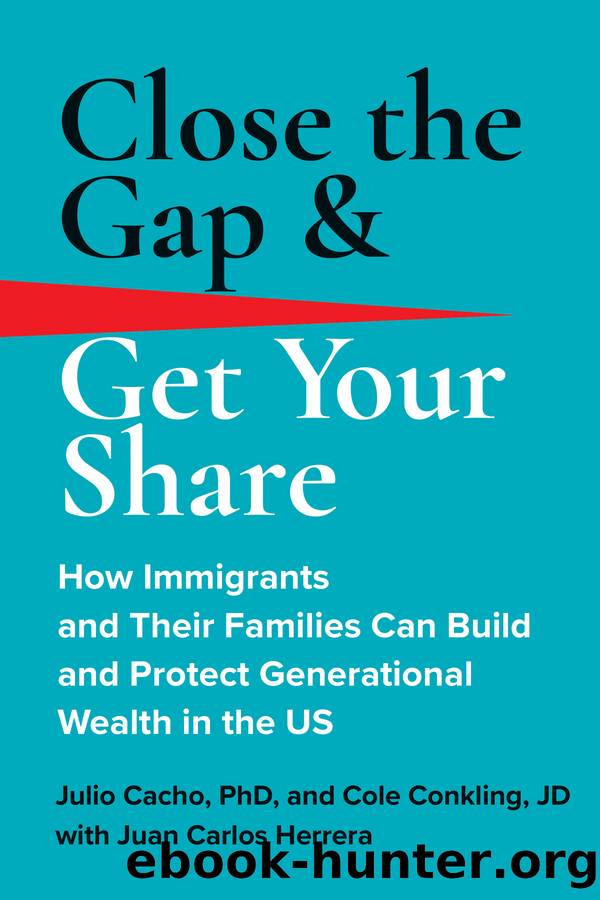Close the Gap & Get Your Share by Julio Cacho Phd

Author:Julio Cacho, Phd
Language: eng
Format: epub
ISBN: 9781637743959
Publisher: BenBella Books
Published: 2023-04-12T00:00:00+00:00
INVEST MORE CASH INTO RISKIER ASSETS
The Global Market Portfolio is safe because itâs maximally diversified. By decreasing diversification, you can add risk, and hopefully higher returns, to the portfolio. As weâve said before, however, not all risks are created equal. It is not enough to simply take âmore riskâ; you must, instead, try to take on more systematic risk and not idiosyncratic risk, like picking stocks.
The first option to increase returns, which is the most common, is to change the Global Market Portfolioâs asset allocation by adding a diversified mix of riskier assets. If youâre risk tolerant, one way to do this is to invest a larger proportion of your moneyâor to invest solelyâin a riskier asset class like stocks, private equity, venture capital, or real estate. If youâre trying to determine what a âriskierâ asset class is, remember that the higher the possible rate of return, the higher the risk. So, since bonds have a low rate of return, that means theyâre a more stable asset class. And since stocks have more exposure to systematic risk, that means they carry greater potential for returns. Investing a larger proportion of your money in a riskier asset class will immediately expose you to more risk and give you a chance for higher returns.
For example, assume that the Global Market Portfolio holds 50 percent bonds, 35 percent stocks, 10 percent real estate, and 5 percent commodities. An investor could increase the risk and expected returns by adding more stocks, so the portfolio holds 65 percent stocks, 20 percent bonds, 10 percent real estate, and 5 percent commodities. By adding more stocks, the risk in the portfolio has been increased, but so have the expected returns. So, instead of expecting 3 to 5 percent average, annual returns, this 65 percent stock portfolio might be expected to return 6 to 8 percent. The problem with this approach, however, is that you are essentially betting against bonds in favor of stocks; you are âover-exposedâ to stocks. Consequently, if the stock market does poorly for a prolonged period, this portfolio will suffer. If you cannot withstand the volatility that additional stocks will bring, this approach may not be for you. Likewise, if you cannot be patient and ride out a potentially extended period of low to no returns, investing in riskier assets might not be good for you.
If you choose this strategy, itâs important to try and have a clear-eyed view of your reasons for doing so, and to be keenly aware of the current market environment. Are you tilting toward more stocks because the stock market has been rising for the last few years and, therefore, you think it will continue to do so forever? Ask yourself what happens if it doesnât. What happens if we go into a bear market or a recession the day after your investment and your portfolio drops 40 percent? Will you stick with the plan, or lose confidence? Itâs very easy to increase your stock allocation when the stock
Download
This site does not store any files on its server. We only index and link to content provided by other sites. Please contact the content providers to delete copyright contents if any and email us, we'll remove relevant links or contents immediately.
International Integration of the Brazilian Economy by Elias C. Grivoyannis(98401)
The Radium Girls by Kate Moore(11967)
Turbulence by E. J. Noyes(7977)
Nudge - Improving Decisions about Health, Wealth, and Happiness by Thaler Sunstein(7655)
The Black Swan by Nassim Nicholas Taleb(7054)
Rich Dad Poor Dad by Robert T. Kiyosaki(6506)
Pioneering Portfolio Management by David F. Swensen(6253)
Man-made Catastrophes and Risk Information Concealment by Dmitry Chernov & Didier Sornette(5951)
Zero to One by Peter Thiel(5729)
Secrecy World by Jake Bernstein(4698)
Millionaire: The Philanderer, Gambler, and Duelist Who Invented Modern Finance by Janet Gleeson(4417)
The Age of Surveillance Capitalism by Shoshana Zuboff(4243)
Skin in the Game by Nassim Nicholas Taleb(4200)
Bullshit Jobs by David Graeber(4136)
The Money Culture by Michael Lewis(4127)
Skin in the Game: Hidden Asymmetries in Daily Life by Nassim Nicholas Taleb(3960)
The Dhandho Investor by Mohnish Pabrai(3721)
The Wisdom of Finance by Mihir Desai(3691)
Blockchain Basics by Daniel Drescher(3535)
